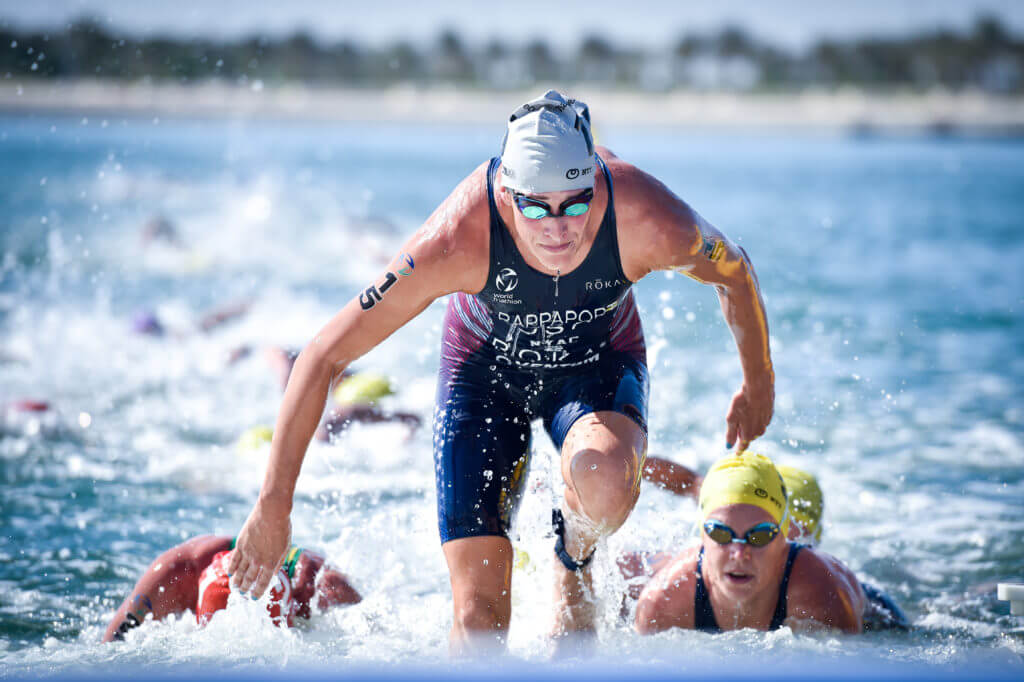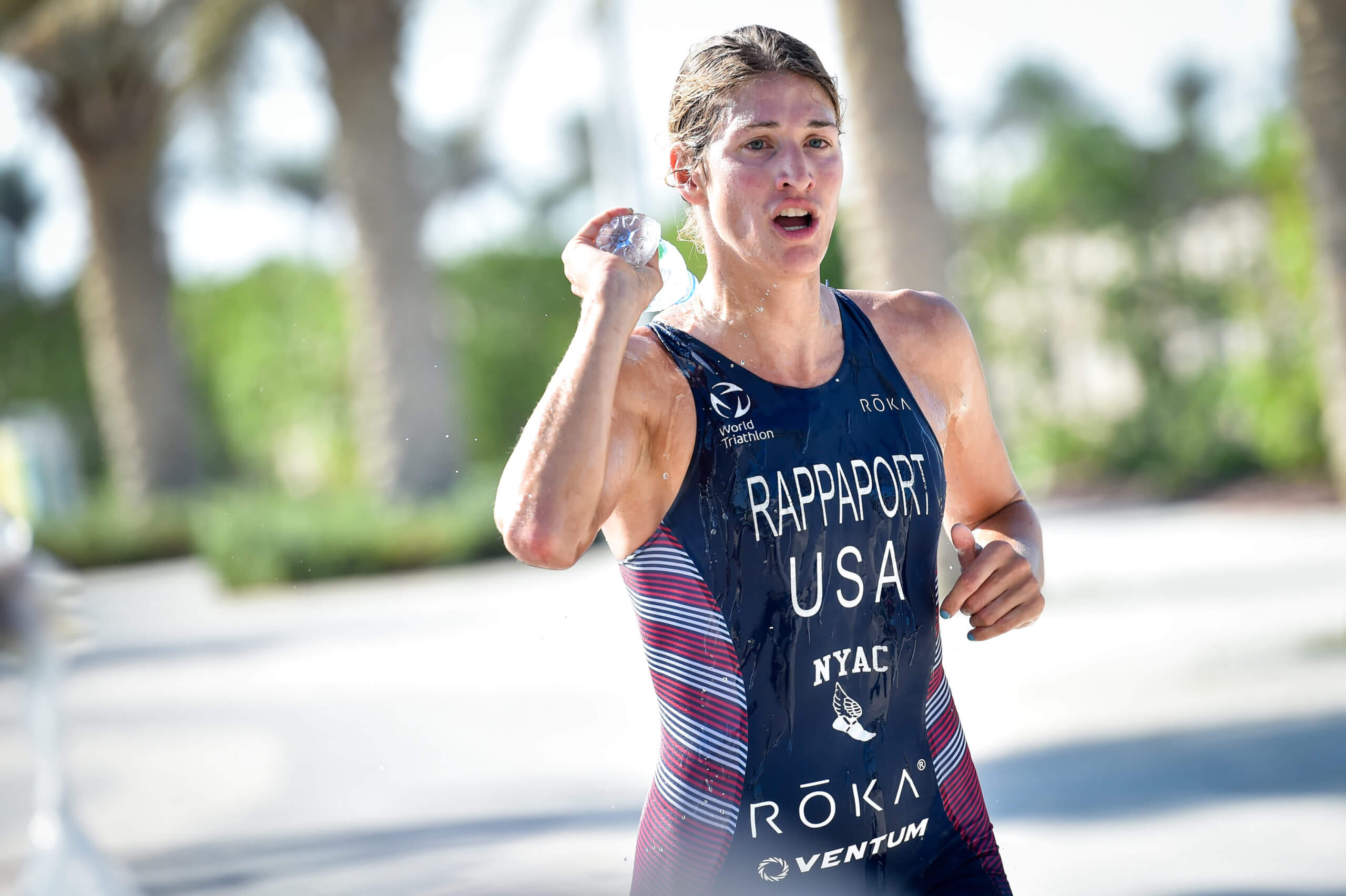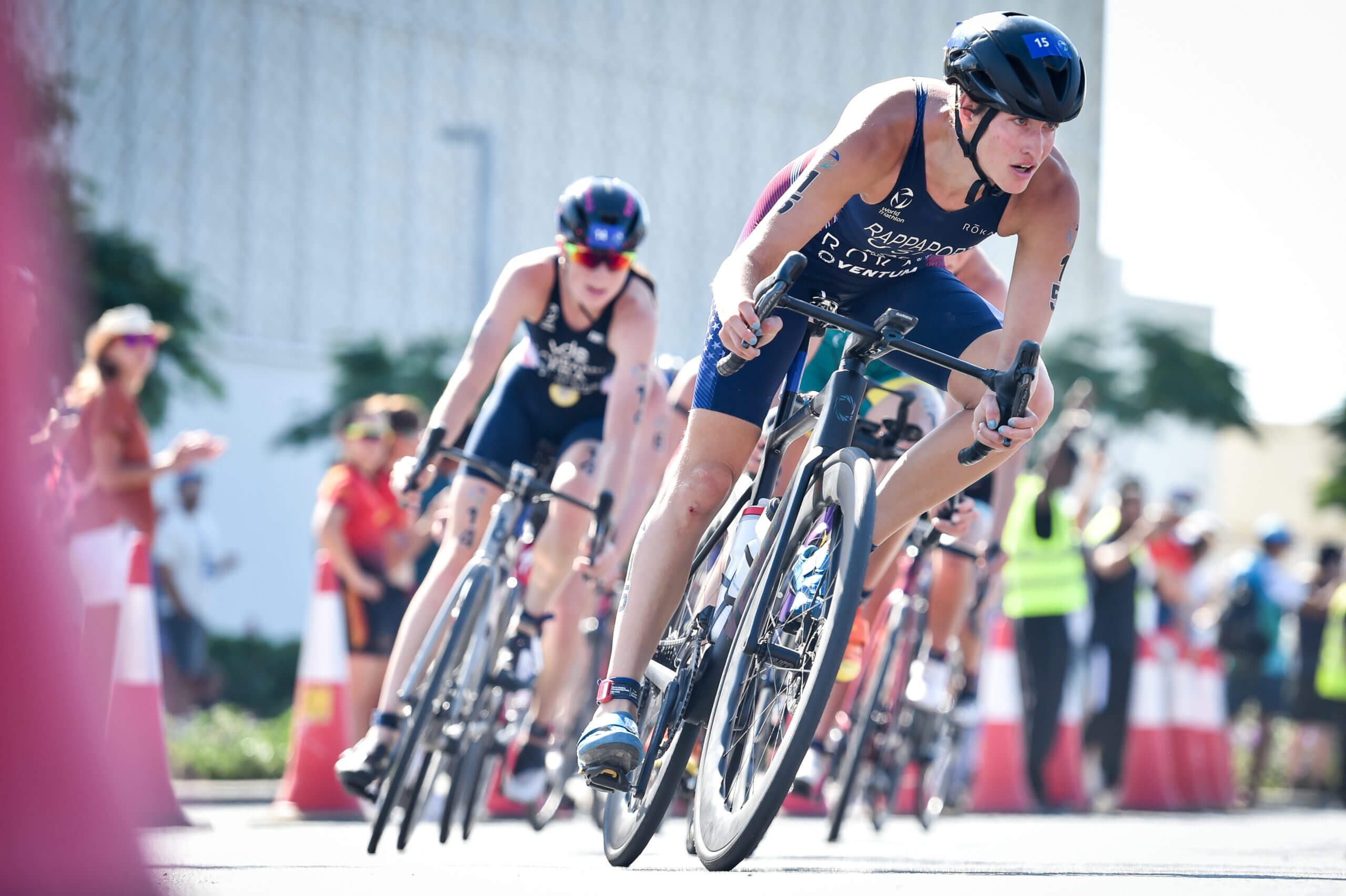Summer Rappaport’s Journey from Villanova Swimming to Olympic Triathlete

Summer Rappaport Journey from Villanova Swimming to Olympic Triathlete
It started out causally enough, though little in Summer Rappaport’s athletic career seems without intention or dedication.
In the spring of 2010, Rappaport had wrapped up a successful freshman season at Villanova University. A distance swimmer from Colorado, she was happy if not fully satisfied by the physical challenge that entailed, and the post-season lull in the schedule left her searching for other competitive outlets. When she found the Broad Street Run, a 10-mile race through Philadelphia, she asked her coach, Rick Simpson, if she could divert some pool time to running.
Simpson assumed there’d be no harm in cross training, given the zeal with which Rappaport (then under her maiden name, Summer Cook) approached aerobic workouts. When Simpson checked Rappaport’s time on race day – and showed his wife Tara, a former college track athlete – the results seemed suspiciously fast: In her first race, Rappaport covered the course in 1 hour, 8 minutes and 20 seconds. That was 34th in the women’s division, 13 minutes behind the winner (Ethiopian Bizunesh Deba, who would go on to the Boston Marathon, Los Angeles Marathon and three times finish in the top 10 of the New York City Marathon).
What had seemed a fanciful idea of walking on to Villanova’s vaunted track team became a notion Simpson supported and that the Wildcats’ then national championship cross country team came to embrace. One thing led to another – to Rappaport competing in three track and field/cross country seasons per year as a junior and senior while still swimming, to two NCAA appearances, to identification by USA Triathlon and finally to Rappaport’s childhood dream of an Olympic Games, in Tokyo in 2021.
“I was always a competitive child, so it was a good competitive outlet for me,” Rappaport said last month. “My goal was always to go to the Olympics as a swimmer, but I didn’t have the talent for that. So I was really grateful when the opportunity opened up for USA Triathlon.”
Getting on Track
Simpson quickly recognized Rappaport as a fit for Villanova during the recruiting process. His reliance on heavy distance training is part of the up-front pitch to recruits. (The program’s biggest accomplishment at the time was sending Maddy Crippen to the 2000 Olympics in the 400 individual medley.) Rappaport wasn’t, he reckons, the top recruit in her class. But the long-time coach recalled Rappaport’s eyes lighting up when he detailed some of the zanier tactics – think a 20,000 for time – the Wildcats employ.

Summer Rappaport; Photo Courtesy: Janos Schmidt/World Triathlon
“When we recruit kids, we’re pretty transparent, we don’t sugarcoat it: We do some pretty crazy stuff in our training,” Simpson said. “… She walked in the door as a distance swimmer and already had this mentality of, I like doing over-the-top things. If it’s long hours, it’s long aerobic stuff, that’s what she was all about. That’s three-quarters of the battle right there.”
Rappaport had the aerobic background and excelled from the start. She posted the top time on the team in the 200 backstroke as a freshman and was third in the 400 IM. She swam at the Big East championships all four years, her best result as a freshman when she took eighth in the mile.
But once her freshman season ended, she was unaccustomed to the gap in her schedule and the prospect of training without an immediate goal ahead. “I wanted to do something else to stay active and challenge myself,” said Rappaport, who double-dipped in swimming and cross country in high school.
That led to Broad Street, and Simpson showing that quick time to Villanova track and field coach Gina Procaccio. At the time, Procaccio wasn’t exactly scrounging for bodies to round out a lineup: She led the Wildcats to the NCAA Cross Country championship in 2009 and 2010, with Sheila Reid winning the individual title in 2010 and 2011. It takes more than enthusiasm and a recommendation to get on the team at ‘Nova, which Rappaport knew well from her time on campus.
“It was very intimidating,” she said. “The other women on the team were very welcoming, but at the time, they had just won the previous two NCAA championships in cross country. We also shared a locker room with them, and to get to that locker room, you had to walk down a hallway of all the Penn Relays wheels that the team had won. So every day on the way to swim practice, I was very, very aware of the track program’s history of success. I definitely felt a little bit like an imposter showing up for my first practices, but the women on the team were very welcoming and very encouraging.”
It started slow. Simpson, still a bit wary of just how fast Rappaport had gone at Broad Street, personally oversaw her two-mile tryout run. Rappaport beat the time with 30 seconds to spare, and Procaccio signed off on letting her train with the team. She competed in a couple of meets in the 2011 outdoor season, her sophomore campaign, before a stress fracture curtailed it, leading to 10 weeks off.
What might have seemed a setback actually was a blessing. Rappaport didn’t stress about feeling out of place when the fall started and she resumed running, because of course she couldn’t keep up with her teammates after the rehab. Instead, she focused on stepwise progress at weekly races against the clock. Seeing time drops each week as she regained fitness and felt healthier fueled her confidence.
“I think that gave me a lot of confidence where it allowed me to focus on myself instead of comparing myself to the other athletes on the team,” she said. “I worked on gradually getting better and being able to support the team where I could as soon as I was able to get the starts at bigger races.”
Bigger, indeed. As a junior in the fall of 2011, she became a reliable scorer in her first cross country season. Procaccio threw her into a local meet at Haverford College where she finished sixth, among Villanova’s runners and overall. She was the sixth Wildcat across the line at the Big East Championships and claimed the fifth and final scoring position at NCAAs, as the Wildcats finished third. By her senior season, she was among Villanova’s top three, on the way to All-Big East honors. She also competed in indoor and outdoor track, such a busy schedule that hardly a week passed without a meet of some kind.
“Physically, what we learned, is that she was an aerobic monster,” Simpson said. “I probably didn’t pick up on that too much in the early phases of her career swimming-wise. We knew she had great aerobic function, but I don’t think we had any idea just to what level until she got into it, and it was like, wow.”
Identifying an Olympic path
The 2000 Sydney Olympics – which Rappaport watched as a kid, dreaming of being an Olympic swimmer – were the first for triathlon. While the sport has a long history as an endurance pursuit, the shorter, draft-legal Olympic version is still a relative newcomer. For USA Triathlon, that has meant exhaustive efforts over the last two decades to identify talent, among elite college athletes, interested in pursuing the sport.
Rappaport’s resume made her a slam-dunk choice. Simpson helped make the introduction to Barb Lindquist, a former Stanford swimmer and Hall of Fame triathlete who served as USAT’s College Recruitment Program Coordinator. Rappaport took it from there. It wasn’t all smooth sailing – Simpson recalls bringing a bike belonging to his wife on deck at Villanova and watching Rappaport flailing away as she struggled to clip into the pedals. (“I definitely knew that I had no bike background, no bike skills, and I had to develop that from scratch,” Rappaport said.)

Summer Rappaport; Photo Courtesy: Janos Schmidt/World Triathlon
She completed her first triathlon in 2013, the summer after graduating. She trained in Colorado Springs, arguably American cycling mecca, before jumping into more serious races the following spring.
It wasn’t long before her career took off. She won a team gold medal and finished fifth individually at the World University Triathlon Championships in Brazil in 2014. In 2015, she got her first significant win, claiming the Catania European Triathlon Union (ETU) European Cup stop. She was on the podium three times in 2016, winning the International Triathlon Union (ITU) World Cup Tongyeong race in October. She was named the ITU Women’s Breakout Star that year.
She’s competed all over the world, with six ITU World Triathlon Series medals (one gold), 13 ITU Triathlon World Cup medals (eight gold) and numerous continental series medals. In 2019, she finished fifth on the ITU World Triathlon Series’ overall rankings.
That August, her fifth-place finish at the Tokyo ITU World Olympic Qualification Event clinched her spot on the 2020 U.S. Olympic team, earned over the same Odaiba Marine Park course that would host the Games one year on.
Or so Rappaport (and all the rest of us) thought, until the COVID-19 pandemic delayed those plans. Unsurprisingly, Rappaport and her legendary work ethic found a way to use the extra time to her benefit. Though she’d turn 30 by the time the Games were rescheduled, age wasn’t a concern, given her late start to the sport. More time on the bike would only shore up the weakness in her program, though she could only maximize that training time in a group setting, away from her home in North Carolina.
She managed to eke out a special exemption to train in 2020, joining The Triathlon Squad training group, led by coach Paolo Sousa, in Portugal. But she raced just once that year – in September, at the World Championships in Hamburg, Germany, placing 17th. The bigger concern was the momentum she carried out of 2019 being grounded by the headwinds of 2020.
“I had a very strong 2019 and just coming to kind of a dead stop in 2020 and only being able to race once, and having only a handful of events in 2021, all of which had really heavy travel restrictions and various other restrictions, I feel like that made it difficult to get back into a rhythm,” she said. “I feel like that was really the most difficult part, where it was coming into a very difficult landscape on race day that I had only experienced a few times before that.”
A Tokyo Dream
Conditions finally improved in 2021. The season started in April with a sixth-place finish at a European Cup stop in Melilla, Spain, then Rappaport finished second (to American teammate Taylor Knibb) at the World Triathlon Championship Series stop in Yokohama, Japan, in May.
That led to the capstone in Tokyo, just two days after Rappaport celebrated her 30th birthday in the Japanese capital.
“For me, it was a pretty focused day, because it was two days before our race,” she said. “We had our race briefing and we had all of these administrative things to take care of, so it was a very, very busy day. But it also was just a dream come true to be at an Olympics Games and experience what I had been dreaming of my entire life. That was really exciting.”
Rappaport finished 14th in Tokyo, her time of 2:00.19 landing 4 minutes, 43 seconds behind winner Flora Duffy of Bermuda and three minutes behind countrywoman Katie Zaferes, who took bronze as the third ever American triathlon Olympic medalist. (True to her roots, Rappaport was fourth after the opening swimming leg, covering 1.5 kilometers in 18:29.) Despite Rappaport finishing ahead of Knibb (in 16th place), Knibb got the start in the debut of the mixed relay four days later, combining with Zaferes, Kevin McDowell and Morgan Pearson (another former swimmer IDed for triathlon) to win silver.
Simpson and the Villanova community followed along at every step. Rappaport’s story fills a very specific niche as the coach pitches the Main Line school to recruits: We care about you as an athlete, and for evidence, look at how flexible we were in helping this Olympian get to the pinnacle.
“We obviously don’t sell it as, ‘hey come to Villanova and we will make you an Olympic swimmer or we will make you an Olympic triathlete,’” he said. “Instead, we sell it as, ‘hey come to Villanova, we love athletes. If you come here, we’re going to support you to be the best athlete at any level.’ Whether that’s an NCAA finalist swimmer, whether it’s a conference champion swimmer, whether it’s a two-sport athlete … if you come to Villanova, that’s what we’re going to help you do.”
Rappaport’s brush with Olympic glory has energized her for the next cycle. Age is not an issue – Zaferes is two years older, and Duffy won gold at 33. With her late start, Rappaport feels, “I still have a lot of good miles in my body.” She’s since relocated to California, following a job change for her husband. The results have continued – third at Worlds in Hamburg in the fall of 2021, a mixed relay team bronze as the anchor at Worlds in Montreal in 2022.
Working toward the Paris Games in 2024 is her next objective. And work has never been an obstacle in her past.
“I think one of the biggest takeaways is just a renewed sense of excitement and passion for the sport,” she said. “I’m definitely coming at it from a different angle than I was a few years ago. I know I have the ability to be an Olympian, and now it’s, what can I do to take those next steps to winning an Olympic medal? And that’s an exciting place to be in.”



